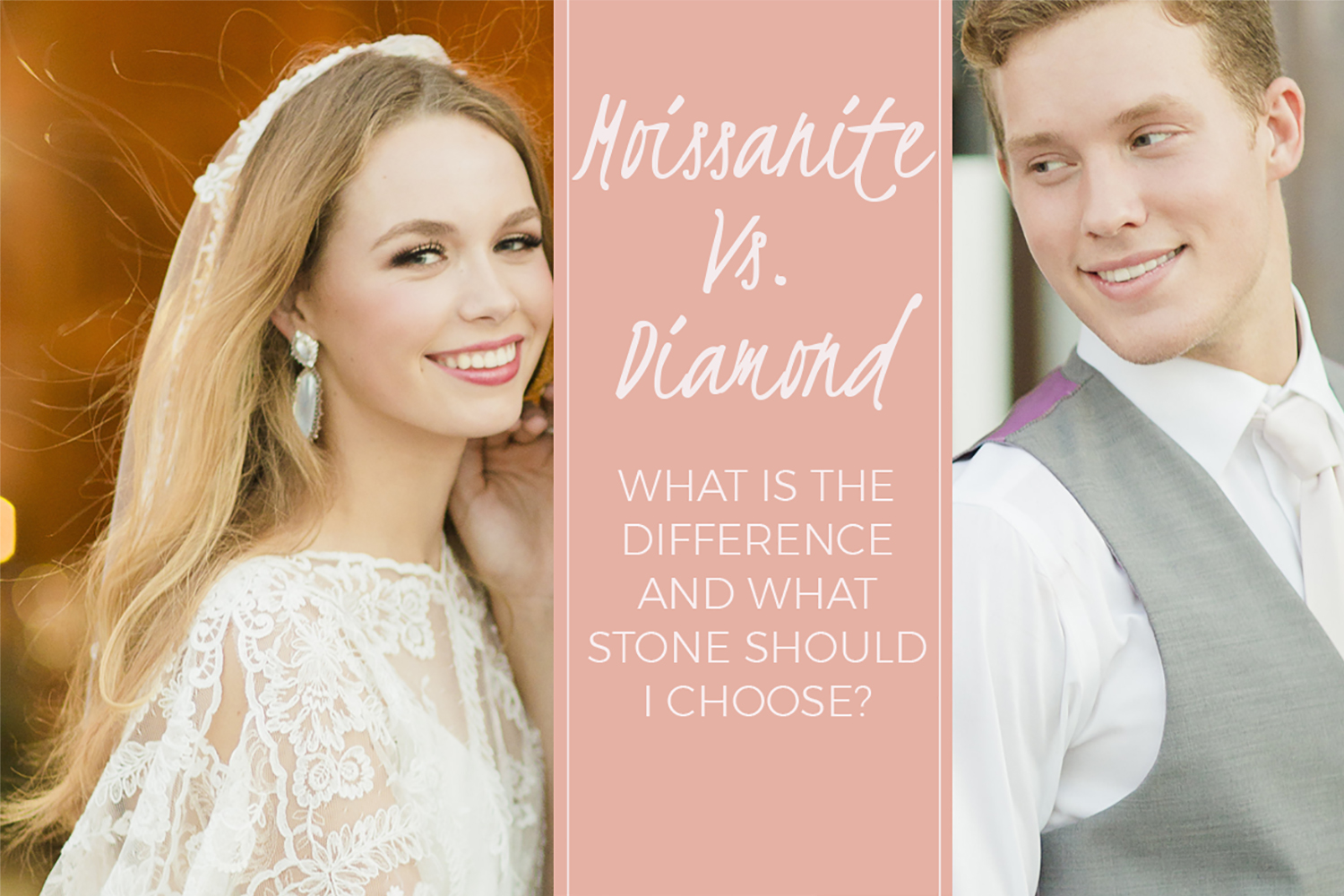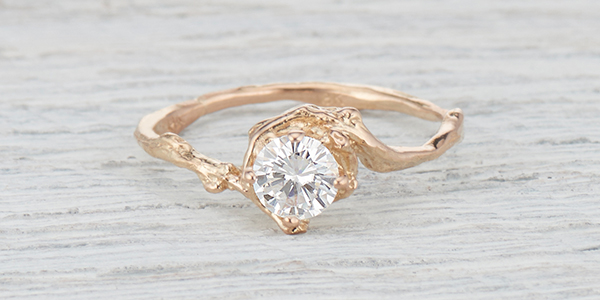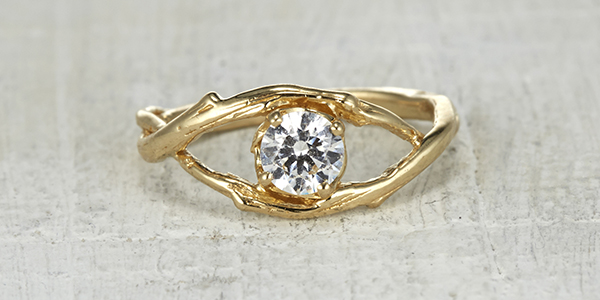Posted by Olivia Ewing on 12th Apr 2018
View Post
Two of the most common questions I'm asked are - what is the difference of Moissanite vs diamond? and is it really worth it to spend more for the diamond? - the first question is pretty factually answered; the second is a little trickier and really depends entirely on your view (or your fiancee's view) of what an engagement ring "should" be...
1. What is a Moissanite? A brief and fascinating history...
Moissanite is a natural silicone carbide crystal originally discovered in 1893 by its namesake Henri Moissan while examining rock samples from a meteor crater in Arizona. He originally thought the samples to be diamond due to their strikingly similar formation.
In its naturally synthesized form, Moissanite is extremely rare on this earth- with a few exceptions, Moissanite is almost always found in meteors, it's quite literally out of this world! And so for almost 100 years, there was no commercially viable use for the stone.
In 1998, Charles & Colvard became the first company to introduce lab grown silicone carbide crystals (Moissanite stones) into the the jewelry market. In recent years, their exclusive patent has expired and Moissanite is now more readily available from a variety of distributers on the market in a pretty large variety of colors, shapes and sizes. By necessity, all Moissanite used for jewelry is synthesized in a lab and never mined from the earth.
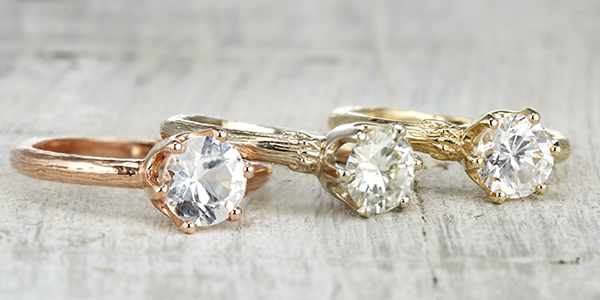
(In order, this shot shows a white sapphire, a Forever Brilliant Moissanite and a diamond)
2. Can you easily tell the difference between a diamond engagement ring and a Moissanite engagement ring?
Color:
When I first started using Moissanite, the answer was yes, there is a definite and obviously noticeable difference between a Moissanite and a diamond. At the time, the highest quality available was a Forever Brilliant Moissanite and this had a distinctly unique yellowish green undertone. If you saw a Moissanite engagement ring alone, it could definitely pass as a diamond, but if you saw it next to a diamond engagement ring, it just looked... different. I always loved setting Moissanite in a rose gold engagement ring to kind of neutralize and offset this color hue which becomes more obvious in white gold or platinum.
A few years ago, all of this changed with the introduction of the Forever One Moissanite. For the first time, they were able to synthesize a nearly colorless stone. Now, when I see a Moissanite engagement ring sitting next to a diamond ring, it's very, very hard to tell the difference. Even in the colorless Moissanite, there is still a slight yellowish green undertone, but it's subtle.
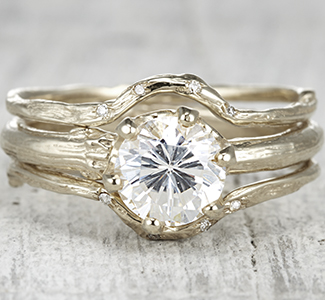
|
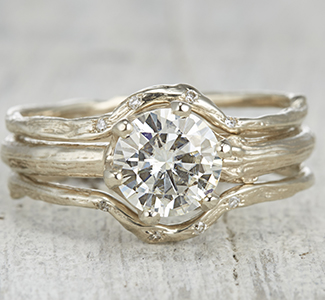
|
|||
|
Diamond Engagement Ring |
Forever Brilliant Moissanite Engagement Ring |
|||
|
|
|
|||

|

|
|||
|
Diamond Engagement Ring |
Forever One Moissanite Engagement Ring |
Dispersion (sparkle):
The biggest giveaway to me in a Moissanite vs a diamond is the different refraction of light. Moissanite disperses light in an almost rainbow-like way. It's a lot more colorful than a diamond. This can be a huge plus to some but others prefer the more subtle refraction of a diamond. Honestly, even with these differences, you'd have to see the two stones side by side and even then, unless you're a jeweler or a gemologist, it may be hard to tell. Of course, the larger the stone, the more amplified and obvious these differences get, so in a large 1+ carat Moissanite, you're going to see a bigger contrast to a diamond.
3. How does the durability of a Moissanite compare to a diamond and how well will it hold up in my engagement ring?
A diamond is the hardest material on earth and virtually un-scratchable. In fact, the only material that can cut a diamond is another diamond. This makes it the ideal stone for an engagement ring. On the universal Moh's scale of hardness, diamonds get a 10 out of 10.
Moissanite, on the other hand, comes in at a 9.25-9.5. While the number sounds very close, it's actually many multiple times softer than a diamond. BUT, it is still an excellent choice for jewelry. Anything above a 9 (in addition to Moissanite and diamond, this includes rubies and sapphires) is pretty safe to use in an everyday ring. So while there are notable differences here, they're not ones that you should necessarily be a deciding factor.
4. Is Moissanite more sustainable or ethical than diamonds?
There is a lot of debate and conflicting views about the diamond industry. Some have merit and others, in my opinion, are overblown. The one hard fact is that every diamond (excluding lab grown diamonds) is mined from the earth. The mining process takes a lot of manpower and a huge amount of energy. Moissanite, by contrast, is always grown in a lab and therefore has much smaller carbon footprint and is much cleaner and sustainable to produce.
5. Will Moissanite hold its value?
While high-quality diamonds generally hold or increase in value over time, the long-term value of Moissanite is less known. While they are projected to increase in value, they simply haven't been around long enough to test the market. Investment wise, diamonds are still a safer bet.
6. Should you buy a Moissanite or save up for the diamond?
There's really no right answer to this question, it completely depends on your budget, the recipient and the type of ring she dreams of.
If size matters:
When it comes to Moissanite vs diamond, Moissanite is significantly more affordable than a diamond and the larger the stone size, the larger that affordability gap becomes. To a lot of people, the price tag attached to a 1+ carat diamond is completely unattainable, so if size is what's important to you in a ring, Moissanite is an easy and attainable answer.
If authenticity matters:
Not to say that Moissanite isn't "real", but it's often considered a diamond alternative. Some women really value the history and natural heritage of a diamond. Every diamond that is mined has already been a part of this earth for thousands of years, which makes it a powerfully symbolic stone. She may not care about size as much and be happy with whatever natural stone you can afford. Even on a tight budget, natural diamonds can be used as accent stones surrounding a colored gemstone.
If sourcing matters:
A lot of couples choose a Moissanite engagement ring not as a diamond alternative, but as a stand-alone stone in its own right. Moissanite comes from a lab and you can feel better about your choice to purchase a stone with a minimal environmental impact that's not associated with the mining industry.
SHOP the entire Moissanite Engagement Ring Collection!
Just a few of our best selling Moissanite rings...
- Naples Rose Gold Moissanite Engagement Ring -
- Unity Solitaire Moissanite Engagement Ring -
- Chelsea Solitaire Moissanite Engagement Ring -


